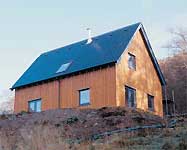Timber cladding in Scotland
The study outlines the development of timber cladding in Scotland, describes timber clad buildings in Scotland, and provides practical information on the use of timber cladding in Scotland.
Timber Cladding in Scotland
HOMEGROWN DOUGLAS FIR
CASE STUDY
HOUSE AT MAULD, STRUY NEAR BEAULY
SIMPSON & BROWN ARCHITECTS

|
Most of the recently designed timber-clad buildings in rural Scotland are inspired by ideas and fashions from outwith their local area. German, Scandinavian or north American practice tends to predominate in 'ecological' housing while the timber cladding design seen in the mainstream kit house market emanates from purely suburban examples. To date, there has been relatively little attempt to utilise the indigenous timber building traditions of Scotland. The house at Mauld near the village of Struy, south west of Beauly, is significant because its simple design draws upon the Scottish timber-clad house-building traditions that existed in rural Scotland prior to World War One. These redwood or whitewood-clad servant's houses and railway stations are still surprisingly common throughout the Highlands, and although some of the temporary buildings are coated with creosote, virtually all of the permanent houses or other buildings have a light-coloured lead paint coating and simple conventional detailing well-suited to a maritime climate. Yet, despite this demonstrable inheritance, the owners and the designer of the house at Mauld still encountered resistance to this 'unconventional' approach. |
Structurally the house has a conventional timber frame, and while better insulated than most, is otherwise technically little different to standard rural kit-houses. The difference lies in its proportions and in the use of brightly-painted softwood cladding which has been carefully detailed for Scottish conditions. Local timber and suppliers have been used wherever possible.
The house is one of a range of designs trying to identify and establish an approach to rural housing which is appropriate to the needs of today. These are adaptable, deliberately unselfconscious designs, and intended to be constructed at mainstream prices. Different specification options are available which can add to or reduce the costs. Each design in the range make considerable use of passive solar design and, because they are well insulated, they are very easy to heat. In this particular example, the house is situated on a small organic farm and will be heated solely from timber harvested from the owners' own land.

|

|
Contact
Email: Central Enquiries Unit ceu@gov.scot
There is a problem
Thanks for your feedback